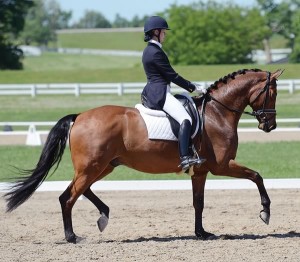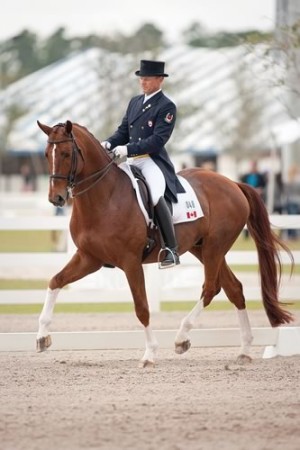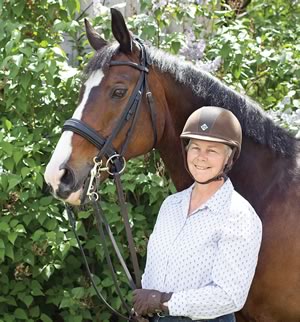Ballet on Horseback
Competition is fierce for spots on the 2015 Pan Am dressage team – and four accomplished equestrians from the Headwaters region are in the thick of the race to represent Canada.

Leah Wilson and Rendezvous perform an extended trot at the Caledon Pan Am Equestrian Park last year. Photo by Doug Palmer.
Leah Wilson has a dream. The 27-year-old equestrian from Palgrave hopes to represent Canada in dressage at the 2015 Pan Am/Parapan Am Games. “The time is right,” Leah says. “I’ve got my fingers crossed. I’m going to give it a shot.”
The fact that the Pan Am equestrian events will take place at the Caledon Pan Am Equestrian Park in Leah’s hometown makes realizing her dream seem tantalizingly close. But she would pursue her goal no matter where the Games were held.
Leah has been riding since she was nine years old and competing internationally since she was 16. Longlisted for the Canadian dressage team from 2004 to 2011, Leah won a silver medal at the 2007 North American Junior and Young Rider Championships. For the past few years, she has set aside her competitive goals to concentrate on building her coaching and training business. But this year, she says, “I’m going full steam ahead with competition.”
With her most promising horse, eight-year-old Rendezvous, Leah, who owns and operates Aislinn Dressage Inc., a training centre near Orangeville, joins a handful of elite dressage riders from the Headwaters region, all of them determined to represent Canada next summer on the pan-American stage.
Other Headwaters’ hopefuls include 48-year-old Tom Dvorak, a veteran dressage competitor from Hillsburgh; 54-year-old Nancy MacLachlan of Terra Cotta; and 23-year-old Megan Lane, who is from Collingwood but now based in Loretto. Starting this summer, these riders and others like them from across the country will begin the long and expensive process of trying to earn one of four berths on the Canadian dressage team.
A sport unlike any other international event, dressage is often called “ballet on horseback” for its combination of grace, beauty, concentration and athleticism. The Fédération Equestre Internationale has defined dressage as “the highest expression of horse training.”
But unlike Grand Prix jumping and cross-country competitions, dressage remains, in North America at least, a somewhat rarefied event little known to the general public. This is understandable, says Leah, who acknowledges that watching a traditional dressage test is not particularly exciting for the uneducated observer. “It’s a disciplined sport,” she says. “You have to understand the difficulties of the moves to fully appreciate it.”

Tom Dvorak and Viva’s Salieri W execute a shoulder-in during the Palm Beach Dressage Derby in Florida. Photo by Pat Girard / Horse Sports Photography.
Tom Dvorak, a trainer and coach who, along with his wife, Ellen, operates Friday Hill Farm near Hillsburgh, rode for Canada at the 1990 World Equestrian Games and at the 1996 Olympics. At both the 2007 Pan Am Games in Brazil and the 2011 Games in Mexico, he placed fourth in the individual events and has a silver medal from the team event in 2007.
Tom laments North Americans’ lack of knowledge of dressage. “It’s been huge in Europe for many years,” says the German native, who came to Canada as a teenager in 1982 and has been competing internationally ever since. “People are more educated in dressage there because it’s a European tradition.”
But, he adds, the sport is definitely growing in popularity here, a fact he attributes largely to the introduction of freestyle dressage to international competition at the 1996 Olympic Games in Atlanta.
In freestyle, or Kür, the program is performed to music. As in figure skating’s free dance, the music and choreography are chosen and created by the competitor, although certain elements and movements must be included in the performance. Unlike the more structured dressage tests, Kür is an impressive, crowd-pleasing spectacle.
Megan Lane recently commissioned Kür composer Joost Peters, who has collaborated with musicians such as Elton John and Sting, to create a freestyle program for her and her own mare, Caravella. “Caravella loves to dance,” says the young head trainer at Deer Ridge, a dressage training facility near Loretto.
“In Florida the stands were packed every night [for Kür],” says Tom, who spent three months this past winter in Wellington, Florida, on the international dressage circuit. “Since we’ve introduced freestyle, dressage has become a lot more fun to watch.”
The Pan Am dressage events take place next summer on July 11 and 14. Teams from North and South America, each consisting of four horses and riders, will complete in team, individual and freestyle tests, and medals will be awarded in each category. At the 2011 Games, 12 teams competed, with the United States taking home gold, Canada silver and Colombia bronze.
During a dressage test, which can last up to seven minutes depending on the level, horse and rider perform a series of movements (see sidebar on page 38) marked on a scale of 1 to 10 by at least five judges, and sometimes as many as seven. The competitors try to maintain the illusion that the horse is executing each movement on its own, without signals from the rider. In fact the rider is using his or her seat, legs and hands to invisibly communicate commands. As Leah Wilson says, “You have to understand the difficulty of the moves. It is very refined.”
This fall, Pan Am hopefuls like Leah, Tom, Nancy and Megan must declare their intention to try out for the Canadian team. To make the team, they must accumulate at least four qualifying test scores, usually with a minimum of 68 per cent, at recognized international competitions. “That doesn’t sound like much,” says Leah, “but in the dressage world it’s a pretty good score.”
Only three qualifying dressage shows will be held in Canada over the next year. The first took place at the Equestrian Park in Palgrave from June 6 to 8. Another will be held in Newmarket from June 19 to 22, and a third is scheduled for Alberta at the end of June.

Nancy MacLachlan shares a quiet moment with Deniros Tyme at MacDay Farm, Nancy’s home near Terra Cotta. Photo by Rachel Dudley.
The Palgrave event, billed as the “CornerStone Spring into Dressage” competition, was hosted by CornerStone Farms. Based in Mono, it has been organizing dressage events for 22 years. According to CornerStone’s Barbara Mitchell, 56 horses, some from as far away as Australia and Brazil, were entered at the international level.
The show was also a test event for the Equestrian Park’s recently completed Grand Prix dressage ring, part of an $11-million upgrade to the facility in preparation for the Games.
Leah, Tom, Nancy and Megan, as well as other Canadians, will also be competing there. But to achieve the four scores necessary to make them eligible for the Pan Am team, they will almost certainly have to travel to Wellington, Florida, next winter. There, a qualifying dressage show will be held nearly every weekend from January until April.
In the runup to the Pan Ams, Leah, Tom and Megan will train and compete on more than one horse. Tom, for example, hopes to qualify on both Viva’s Salieri W, owned by Carla Bahr, and Ribot, owned by Augustine and Christine Walch. And in addition to Caravella, Megan is grooming two other horses, both owned by sponsors, whose support is often essential for elite riders. If Megan earns a berth on the Canadian team, the horse she teams up with at the Games will be the one that racks up the highest scores in the qualifying competitions. “The marks will decide,” she says.
All four acknowledge it’s a big commitment in terms of both time and money. But it’s also a huge party. “It’s like being at a resort with 3,000 of your best friends,” says Leah of the Wellington circuit. The community just west of Palm Beach has become the epicentre of international dressage and jumping, attracting top riders from around the world. “It’s like Disney World for horses,” she says.
When, and if, they earn four qualifying scores, Canadian dressage contenders must submit them to Dressage Canada, the sport’s governing body, which has the final say in choosing the Pan Am team. According to Christine Peters of Dressage Canada, the final selection may be made after a “trial” show featuring the top eight riders.
Nancy MacLachlan, who owns and operates MacDay Farm with her husband, Dr. Alan Young, knows the competition will be stiff. An experienced international rider who competed for Canada at the 1995 Pan Ams in Argentina, as well as the 1998 and 2002 World Championships, Nancy is grateful to Julia Fogel, owner of Deniros Tyme, for providing her with an opportunity to test her mettle on the 16-year-old gelding with the strong dressage pedigree.
But she is realistic about her chances. “You’ve really got to be on top of your game to make the team,” Nancy says. Still, she also knows that unlike in many other athletic disciplines, age is actually an advantage for dressage riders. “It may hurt more, but we keep getting better at it,” she says.
Tom, who has 30 years’ experience in the sport, concurs: “Dressage riders age like red wine. We can be competitive until well into our 60s. I do things better now than I did 20 years ago.”
Tell that to Megan, who, at only 23 years old, is a rising star in Canadian dressage circles. She has been competing since she was five and has won eight medals at the North American Junior and Young Rider Championships. This August she will compete in Europe for the first time at the World Equestrian Games in Normandy, France. Like Leah, Megan has a dream – of competing in the Pan Am Games and, who knows, maybe the Olympics some day. “I feel like the stars are really aligned for me,” she says.
It will take more than luck, however, for the Headwaters’ hopefuls to realize their dreams. The Games are still more than a year away, and it will be a year of hard work, of riding, training and showing. Theirs is a big dream that takes a big commitment to make it come true.
“Being on these teams,” says Nancy, “is a huge deal. You’re riding for your country, so you want to do a good job.”
More Info
Dressage
A primer for the neophyte
This glossary won’t make you an expert in dressage, but it may help you appreciate some of the moves required at the highest levels of this equestrian sport.
Gaits — There are three: walk, trot and canter.
Collected Gaits — The horse walks, trots or canters with its hindquarters tucked underneath and most of the weight in its back end. The horse appears to be moving uphill.
Extended Gaits — The horse lengthens its stride showing great power and thrust in the trot and canter, and stretch and relaxation at the walk.
Pirouette — Usually at a canter, the horse makes a full or half circle on the spot with its hind end in place.
Half Pass — The horse trots sideways and forwards on the diagonal, its legs crossing over one another.
Piaffe — A high-stepping movement done on the spot, with the horse stepping up and down in place or nearly in place.
Flying Change — At a canter, the horse changes its leading foreleg, and at the same time, the hind leg. Failure to change the hind leg is a serious fault. This move may be performed in succession on every second, third or fourth stride, but the most skilled teams can perform the move on every stride.
Passage — (pronounced pa-sawj) A collected, cadenced trot characterized by elevated movement of the knees and hocks. Sometimes called a “hovering trot.”









